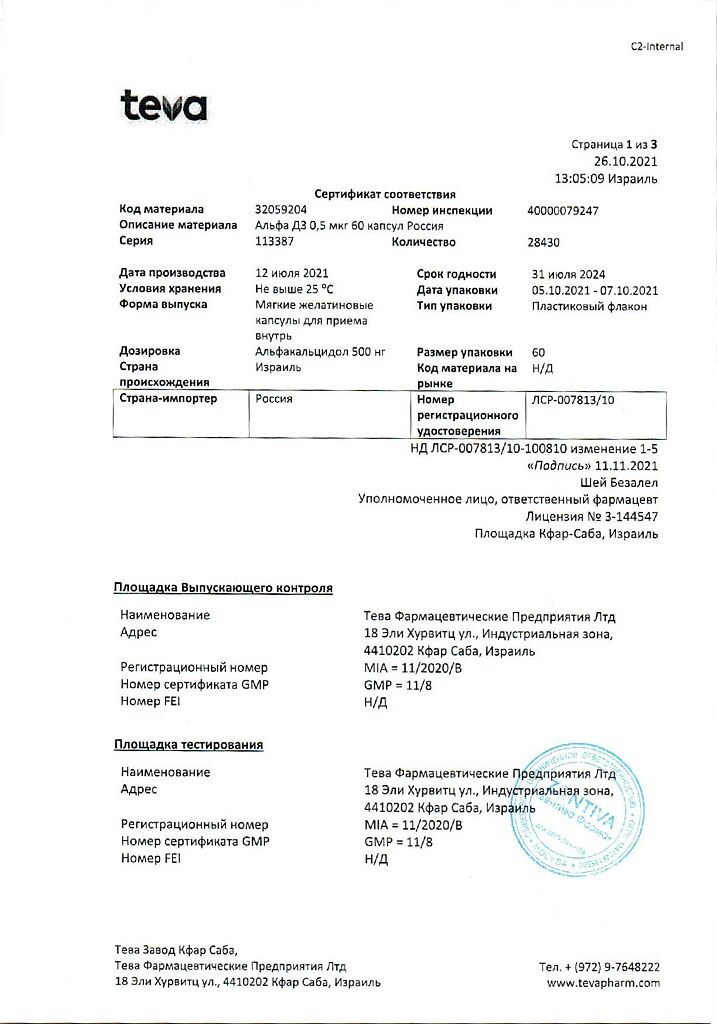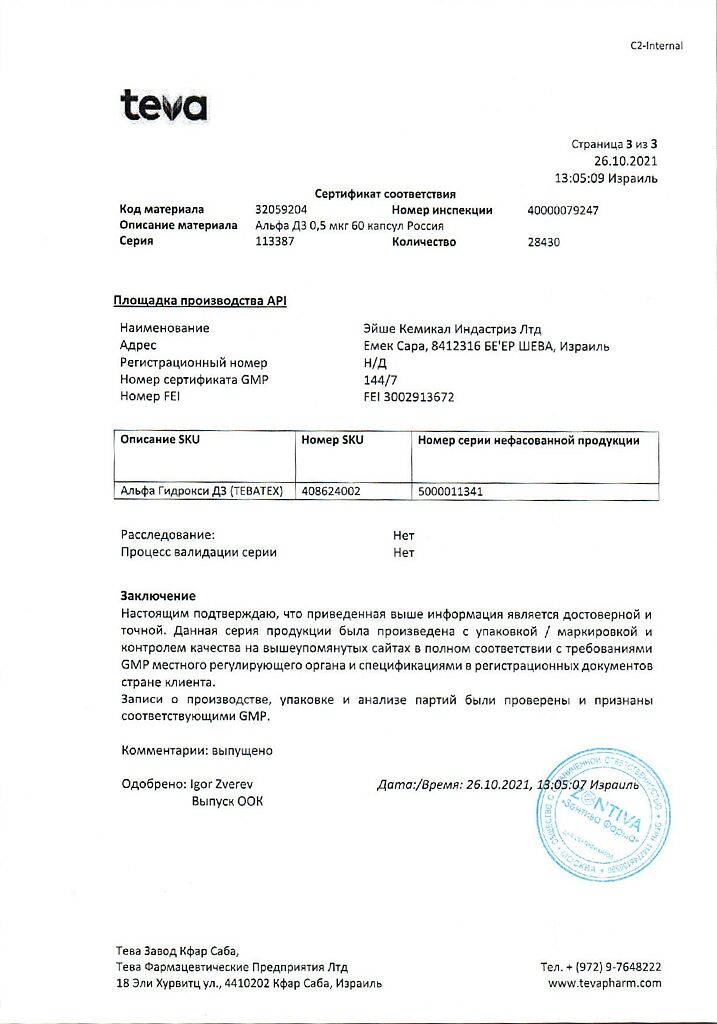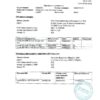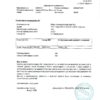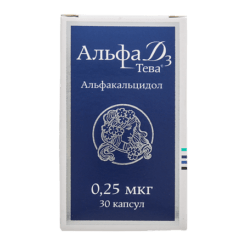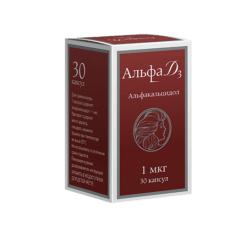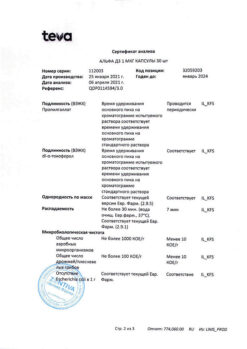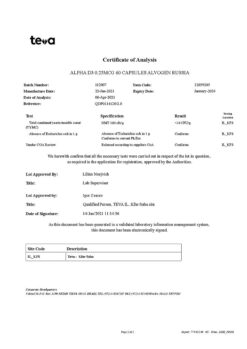No products in the cart.
Alpha D3, 0.5 mcg capsules 60 pcs
€1.00
Out of stock
(E-mail when Stock is available)
Description
Alpha D3-Teva is a calcium-phosphorus metabolism regulator.
Pharmacodynamics
. Alfacalcidol (1α-hydroxyvitamin D3) is rapidly converted in the liver to 1,25-dihydroxyvitamin D3, the active metabolite of vitamin D (calcitriol), which acts as a regulator of calcium and phosphorus metabolism. It increases the absorption of calcium and phosphorus in the intestine, increases their reabsorption in the kidneys, restores a positive calcium balance in the treatment of calcium malabsorption syndrome and reduces the blood concentration of parathyroid hormone. Influencing both parts of bone remodeling process (resorption and synthesis), alfacalcidol not only increases mineralization of bone tissue, but also increases its elasticity by stimulating synthesis of bone matrix proteins, bone morphogenetic proteins and bone growth factors, which promotes reduction of fracture frequency.
In elderly patients with endocrine-immune dysfunction, including D-hormone (calcitriol) production deficiency, the decrease of total muscle mass (sarcopenia) and the appearance of muscle weakness syndrome (due to the disturbance of normal neuromuscular system functioning), accompanied with increased risk of falls and the resulting injuries and fractures. A number of studies have shown a significant reduction in the incidence of falls in elderly patients when using alfacalcidol. Alfacalcidol stimulates the regeneration of muscle fibers, which restores lost muscle tone.
Pharmacokinetics
Absorption.After oral administration, alfacalcidol is rapidly absorbed from the gastrointestinal tract. Cmax in plasma is reached 8-12 hours after a single dose of alfacalcidol.
Metabolism. Conversion of alfacalcidol into calcitriol (1,25-dihydroxycalciferol) occurs in the liver by hydroxylation at the 25 carbon atom, and the hydroxylation process occurs very rapidly (has a substrate-dependent nature). Unlike native vitamin D, alfacalcidol does not require hydroxylation in kidneys, therefore it is effective even in patients with decreased activity of renal 1-alpha-hydroxylase (kidney pathology and old age).
Indications
Indications
Active ingredient
Active ingredient
Composition
Composition
1 capsule contains:
The active ingredient:
alfacalcidol – 0.5 mcg.
Associates:
citric acid anhydrous – 0.015 mg,
propyl gallate – 0.02 mg,
α-tocopherol (vit. E) – 0.02 mg,
ethanol – 1.145 mg,
peanut butter – up to 100 mg.
Composition of the soft gelatin capsule:
Gelatin – 48.35 mg,
glycerol – 11.81 mg,
anidrisorb 85/70 – 7.89 mg (sorbitol – 24-40%, sorbitan – 20-30%, mannitol – 0-6%, higher polyols – 12.5-19%, water – 15-17%),
Red iron oxide dye (E172) – 0.043 mg,
Titanium dioxide (E171) – 0.65 mg.
Content of black ink:
shellac – 54%,
iron oxide dye black (E172) – 46%.
How to take, the dosage
How to take, the dosage
Overly, regardless of meals, without chewing, with plenty of fluid, once a day. Recommended daily dose of the drug Alpha D 3 -Teva can be taken all at once, or the dose can be divided into 2 doses. Therapy may last from 2-3 months to 1 year or more.
The duration of treatment is determined by the doctor for each patient individually.
From 1 to 3 mcg/d for at least 2 to 3 months.
From 2 to 4 mcg/d.
From 1 to 2 mcg/d for 2-3 months 2-3 times a year.
From 2 to 6 mcg/d.
Therapy starts with a dose of 4 mcg/day. The maximum daily dose can reach 20 mcg.
If high doses are prescribed, consider switching to a higher dosage of Alpha D3-Teva capsules (Alpha D3-Teva capsules 1 mcg disp. 30 Teva Pharmaceuticals Ltd.) or other dosage forms of alphacalcidol.
From 0.5 to 1 mcg/day. It is recommended to start therapy with the lowest of these doses, controlling the calcium and phosphorus levels in blood plasma once a week. The drug dose can be increased by 0.5 mcg/day until the biochemical parameters are stabilized.
From 1 to 3 mcg/day for at least 2-3 months.
From 0.5 to 1 mcg/d for 2-3 months 2-3 times a year.
From 2 to 6 mcg/d.
In hypophosphatemic rickets and osteomalacia
Therapy starts with a dose of 1 mcg/day.
Interaction
Interaction
In the treatment of osteoporosis alfacalcidol may be prescribed in combination with estrogens and drugs that reduce bone resorption.
The simultaneous use of alfacalcidol with foxglove drugs increases the risk of arrhythmia.
The inducers of microsomal liver enzymes (including phenytoin and phenobarbital ) decrease and inhibitors increase the plasma concentration of alfacalcidol (its effectiveness may change).
Alfacalcidol absorption is decreased when co-administered with mineral oil (for a long time), colestyramine, colestipol, sucralfate, antacids, albumin-based preparations.
The use of antacids increases the risk of hypermagnesemia and hyperaluminemia.
The toxic effects are weakened by retinol , tocopherol , ascorbic acid , pantothenic acid , thiamine , riboflavin .
Calcitonin, derivatives of etidronic and pamidronic acids, plikamycin, gallium nitrate and glucocorticosteroids reduce the effect.
Alfacalcidol increases absorption of phosphorus-containing drugs and the risk of hyperphosphatemia.
Concomitant use of alfacalcidol with calcium preparations, thiazide diuretics may cause hypercalcemia due to increased absorption of calcium in intestine, increased reabsorption in kidneys.
With alfacalcidol therapy other medicinal products of vitamin D and its derivates should not be administered because of possible additive interaction and increase of risk of hypercalcaemia development.
Special Instructions
Special Instructions
The therapy should be carried out under constant control of calcium and phosphate concentrations in blood (at the beginning of treatment – once a week, when reaching and during the whole period of treatment – calcium concentration in plasma and urine every 3-5 weeks), as well as activity of alkaline phosphatase (ALP) (in CPN – weekly control). In CKD it is required preliminary correction of hyperphosphatemia.
When plasma alkaline phosphatase content is normalized, the dose of the drug Alpha D 3 -Teva should be decreased to avoid the development of hypercalcemia. Hypercalcemia or hypercalciuria is corrected by discontinuation of the drug and reduction of calcium intake until normalization of plasma calcium concentration. As a rule, this period is 1 week. After normalization, therapy is continued by administering half of the last dose used. It should be kept in mind that sensitivity to vitamin D is individual for different patients and even therapeutic doses may cause hypervitaminosis in some patients.
In children receiving vitamin D for a long time the risk of stunting increases. For the prevention of hypovitaminosis D, a balanced diet is most preferable.
In old age, the need for vitamin D may increase due to decreased absorption of vitamin D, decreased ability of the skin to synthesize provitamin D 3 , decreased insolation time, and increased frequency of renal failure.
Contraindications
Contraindications
With caution The drug should be prescribed in nephrolithiasis, atherosclerosis, chronic heart failure, chronic renal failure, sarcoidosis or other granulomatosis, pulmonary tuberculosis (active form), patients with increased risk of hypercalcemia, especially in the presence of urolithiasis, children over 3 years old.
Side effects
Side effects
Nervous system disorders:general weakness, fatigue, headache, dizziness, somnolence.
Allergic reactions:skin rash, itching.
Musculoskeletal side:moderate pain in muscles, bones, joints.
Laboratory findings:hypercalcemia, slight increase in HDL concentration; possible development of hyperphosphatemia (in patients with significant renal dysfunction).
Systemic diseases: tachycardia, increased BP.
Gastrointestinal system disorders:anorexia, vomiting, heartburn, abdominal pain, nausea, dry oral mucosa, discomfort in epigastric region, constipation, diarrhea, slight increase of liver enzymes activity.
Overdose
Overdose
Symptoms:Early symptoms of hypervitaminosis D (due to hypercalcemia): Diarrhea, constipation, nausea, vomiting , dry mouth, anorexia , metallic taste in mouth, hypercalciuria, polyuria, polydipsia, pollakiuria/nicturia, headache, fatigue, general weakness, myalgia , bone pain.
Late symptoms of hypervitaminosis D:dizziness, confusion, drowsiness, blurred urine, heart rhythm disorders, skin itching, increased blood pressure, conjunctival hyperemia, nephrolithiasis, weight loss, photophobia, pancreatitis, gastralgia. Rarely – psychosis (change of mind and mood).
The symptoms of chronic vitamin D intoxication: calcification of soft tissues, blood vessels and internal organs (kidneys, lungs), renal and cardiovascular failure up to death, growth disorders in children.
Treatment:The drug should be discontinued. In the early terms of acute overdose – gastric lavage, prescription of mineral oil (Vaseline), which helps to reduce absorption and increase excretion through the intestine. In severe cases it may be necessary to carry out supportive therapeutic measures – hydration with infusion of saline solutions (forced diuresis), in some cases – prescription of glucocorticosteroids, loop diuretics, bisphosphonates, calcitonin and hemodialysis with solutions with low calcium content. It is recommended to monitor the blood electrolyte content, renal function and cardiac status according to electrocardiogram especially in patients receiving digoxin.
Pregnancy use
Pregnancy use
In pregnancy (II-III trimester) alfacalcidol is prescribed only if the expected benefit to the mother exceeds the possible risk to the fetus.
In animal experiments it was shown that calcitriol in doses 4-15 times higher than the recommended doses for humans has a teratogenic effect.
Hypercalcemia in the mother during pregnancy associated with prolonged overdose of vitamin D may cause fetal hypersensitivity to vitamin D, suppression of parathyroid function, specific elf-like appearance syndrome, mental retardation, and aortic stenosis.
The drug is contraindicated for use during breastfeeding.
Similarities
Similarities
Additional information
| Shelf life | 3 years |
|---|---|
| Conditions of storage | At a temperature not exceeding 25 °C |
| Manufacturer | Catalent Germani Eberbach GmbH, Germany |
| Medication form | capsules |
| Brand | Catalent Germani Eberbach GmbH |
Other forms…
Related products
Buy Alpha D3, 0.5 mcg capsules 60 pcs with delivery to USA, UK, Europe and over 120 other countries.


